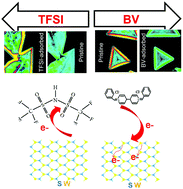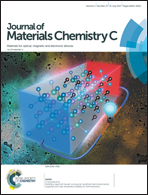Heterogeneous modulation of exciton emission in triangular WS2 monolayers by chemical treatment†
Abstract
Chemical treatments were recently shown to be very effective in enhancing the exciton emission of monolayer transition metal dichalcogenides (1L-TMDs) by suppressing the exciton quenching caused by structural defects. However, the effects of these chemical treatments varied greatly depending on the synthesis method and the type of 1L-TMD; therefore, the exact origin of the emission enhancement is still elusive. Here we report the spatially heterogeneous effects of bis(trifluoromethane)sulfonimide (TFSI) and benzyl viologen (BV) treatment on the optical properties of triangular 1L-WS2 grown by chemical vapor deposition (CVD). Nanoscale photoluminescence (PL) and Raman spectral maps showed that TFSI had a minimal effect on the inner region of the triangular WS2 grain, whereas the PL of the edge region was enhanced up to 25 times; further, BV reduced the PL, also more strikingly in the edge region. Systematic variation of the spectral weights among neutral excitons, trions, and bi-excitons indicated that p-doping and n-doping with TFSI and BV, respectively, occurred in both the inner and edge regions; however, the PL enhancement was attributed mainly to the reduction of structural defects caused by TFSI treatment. Our observation of the spatially heterogeneous effects of chemical treatment suggests that the inner and edge regions of CVD-grown 1L-WS2 are populated with different types of structural defects and helps in clarifying the mechanism by which chemical treatment enhances the optical properties of 1L-TMDs.



 Please wait while we load your content...
Please wait while we load your content...